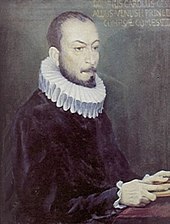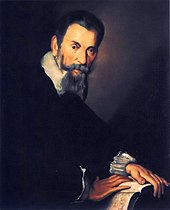Music history of Italy
| Music of Italy | ||||||||
| General topics | ||||||||
|---|---|---|---|---|---|---|---|---|
|
||||||||
| Genres | ||||||||
| Specific forms | ||||||||
| Gregorian chant | ||||||||
| Media and performance | ||||||||
|
||||||||
| Nationalistic and patriotic songs | ||||||||
|
||||||||
| Regional music | ||||||||
|
||||||||
| History of Italy |
|---|
 |
|
|
The modern state of Italy did not come into being until 1861, though the roots of music on the Italian Peninsula can be traced back to the music of ancient Rome. However, the underpinnings of much modern Italian music come from the Middle Ages.
Before 1500
Italy was the site of several key musical developments in the development of the Christian liturgies in the West. Around 230, well before Christianity was legalized, the

The earliest extant music in the West is
Even as the northern chant traditions were displacing indigenous Italian chant, displaced musicians from the north contributed to a new thriving musical culture in 12th-century Italy. The
Between 1317 and 1319,
The Ivrea Codex, dated around 1360, and the Squarcialupi Codex, dated around 1410, were major sources of late Trecento music, including the music of Francesco Landini, the famous blind composer. Landini's name was attached to his characteristic "Landini cadence" in which the final note of the melody dips down two notes before returning, such as C–B–A–C. Trecento music influenced northern musicians such as Johannes Ciconia, whose synthesis of the French and Italian styles presaged the "international" music typical of the Renaissance.
During the 15th century, Italy entered a slow period in native composition, with the exception of a few bright lights such as the performer and anthologist Leonardo Giustinian. As the powerful northern families such as the
Renaissance era, 16th century

The 16th century saw the advent of printed polyphonic music and advances in instrumental music, which contributed to the international distribution of music characteristic of the Renaissance. In 1501,

Music achieved new heights of cultural respectability.
Music was not immune to the politically charged atmosphere of Renaissance Italy. In 1559, Antonio Gardano published Musica nova, whose politically pro-republican partisan songs pleased the northern Italian republics and riled the Church.
In the late 16th century and early 17th century, composers began pushing the limits of the Renaissance style. Madrigalism reached new heights of emotional expression and chromaticism in what
Baroque era, 16th – 18th centuries

The exact nature of
The years 1600 to 1750 encompass the

The physical resources for music advanced greatly during the 18th century. The great opera houses in Naples and Milan were built: the
Important Italian composers in this century are: Domenico Scarlatti, Benedetto Marcello, Giovanni Battista Pergolesi, Niccolò Piccinni, Giovanni Paisiello, Luigi Boccherini, Domenico Cimarosa, and Luigi Cherubini. It is also the age in which Italian music became international, so to speak, with many Italian composers beginning to work abroad.

19th century
The 19th century is the age of Romanticism in European literature, art, and music. Italian opera forsakes the

Perhaps the most noteworthy feature of Italian musical form in the 19th century, and that which distinguishes it from musical developments elsewhere, is that it remained primarily operatic. All significant Italian composers of the century wrote opera almost to the exclusion of other forms, such as the symphony.[17] There are no Italian symphonists in this century, the way one might speak of Brahms in Germany, for example. Many Italian composers, however, did write significant sacred music, such as Rossini a Stabat Mater and his late Petite messe solennelle and Verdi Messa da Requiem and Quattro pezzi sacri.
Romanticism in all European music certainly held on through the start of the 20th century. In Italy, the music of Verdi and Puccini continued to dominate for a number of years. Even the realistic plots and more modern compositional techniques of the operas of Italian verismo, such as Mascagni's Cavalleria rusticana, did not greatly affect the extremely melodic nature of Italian music.
Notes
- ^ McKinnon 1991, pp. 318–320.
- ^ Ulrich & Pisk 1963, p. 27.
- ^ Hiley 1995, p. 546.
- ^ Ulrich & Pisk 1963, p. 33.
- ^ Gallo 1995, p. [page needed].
- ^ Ulrich & Pisk 1963, p. 185.
- ^ Hoppin 1978, p. 438.
- ^ Atlas 1998, p. 494.
- ^ Atlas 1998, p. 406.
- ^ Atlas 1998, p. 583.
- ^ Palisca 1985, p. 408.
- incomplete short citation]
- ^ Magrini 1992, p. [page needed].
- ^ Ulrich & Pisk 1963, p. 220.
- ^ Crocker 1966, p. 341.
- ^ Crocker 1966, p. 473.
- ^ Crocker 1966, ch. 13.
References
- Atlas, Allan W. (1998). Renaissance Music. New York: W. W. Norton & Company. ISBN 0-393-97169-4.
- Crocker, Richard L (1966). A History of Musical Style. New York: McGraw-Hill. ISBN 0-486-25029-6.
- Gallo, Alberto (1995). Music in the Castle: Troubadours, Books and Orators in Italian Courts of the Thirteenth, Fourteenth and Fifteenth Centuries. Chicago: University of Chicago Press. ISBN 0-226-27968-5.
- Hiley, David (1995). Western Plainchant: A Handbook. Clarendon Press. ISBN 0-19-816572-2.
- Hoppin, Richard (1978). Medieval Music. New York: W. W. Norton & Company. ISBN 0-393-09090-6.
- Magrini, Tullia, ed. (1992). Il maggio drammatico: una tradizione di teatro in musica (in Italian). Bologna: Edizioni Analisi.
- McKinnon, James, ed. (1991). Antiquity and the Middle Ages. Eaglewood Cliffs: Prentice Hall. ISBN 0-13-036153-4.
- ISBN 0-300-04962-5.
- Ulrich, Homer; Pisk, Paul (1963). A History of Music and Musical Style. New York: Harcourt Brace Jovanoich. ISBN 0-15-537720-5.
